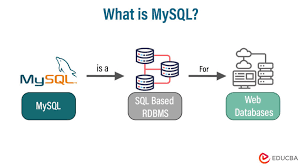连接数据库的步骤 {#连接数据库的步骤}
众所周知,MySQL数据库是一个典型的C/S结构,即:客户端和服务器端。如果我们部署好了MySQL服务器,想要在客户端访问服务器端的数据,在编写程序的时候就可以通过官方提供的C语言的API来实现。
在程序中连接MySql服务器,主要分为已经几个步骤:
-
初始化连接环境
-
连接mysql的服务器,需要提供如下连接数据:
- 服务器的IP地址
- 服务器监听的端口(默认端口是3306)
- 连接服务器使用的用户名(默认是 root),和这个用户对应的密码
- 要操作的数据库的名字
-
连接已经建立, 后续操作就是对数据库数据的添删查改
-
这些操作都是需要通过sql语句来完成的
-
数据查询:通过调用api 执行一个查询的sql语句
-
数据修改(添加/删除/更新):通过调用api 执行一个修改数据的sql语句
-
-
如果要进行数据 添加/ 删除/ 更新,需要进行事务的处理
- 需要对执行的结果进行判断
- 成功:提交事务
- 失败:数据回滚
- 需要对执行的结果进行判断
-
数据库的读操作 -> 查询 -> 得到结果集
-
遍历结果集 -> 得到了要查询的数据
-
释放资源
MySQL C API {#MySQL-C-API}
对于以上的操作步骤,在MySQL提供的API中都有对应的操作函数,下面,为大家介绍一下这些API函数的使用。
初始化连接环境 {#初始化连接环境}
|-----------------|---------------------------------------------------------------------------------------------------------------------|
| 1 2 3 4 | // 参数 mysql -> null // 返回值: 该函数将分配、初始化、并返回新对象 // 通过返回的这个对象去连接MySQL的服务器 MYSQL *mysql_init(MYSQL *mysql) ; |
连接mysql服务器 {#连接mysql服务器}
|---------------------------------------------------|---------------------------------------------------------------------------------------------------------------------------------------------------------------------------------------------------------------------------------------------------------------------------------------------------------------------------------------------------------------------------------------------------------------------------------------------------------------------------------------------------------------------------------------------------------------------------------------------------------------------------|
| 1 2 3 4 5 6 7 8 9 10 11 12 13 14 15 16 17 | /* 返回值: 成功: 返回MYSQL*连接句柄, 对于成功的连接,返回值与第1个参数的值相同。返回值指向的内存和第一个参数指针指向的内存一样 失败,返回NULL。 句柄: 是windows中的一个概念, 句柄可以理解为一个实例(或者对象) */ MYSQL *mysql_real_connect( MYSQL *mysql, // mysql_init() 函数的返回值 const char *host, // mysql服务器的主机地址, 写IP地址即可 // localhost, null -> 代表本地连接 const char *user, // 连接mysql服务器的用户名, 默认: root const char *passwd, // 连接mysql服务器用户对应的密码, root用户的密码 const char *db, // 要使用的数据库的名字 unsigned int port, // 连接的mysql服务器监听的端口 // 如果==0, 使用mysql的默认端口3306, !=0, 使用指定的这个端口 const char *unix_socket,// 本地套接字, 不使用指定为 NULL unsigned long client_flag); // 通常指定为0 |
执行sql语句 {#执行sql语句}
|-------------------------|------------------------------------------------------------------------------------------------------------------------------------------------------------------------------------------------------------------------|
| 1 2 3 4 5 6 7 8 | // 执行一个sql语句, 添删查改的sql语句都可以 int mysql_query(MYSQL *mysql, const char *query); 参数: - mysql: mysql_real_connect() 的返回值 - query: 一个可以执行的sql语句, 结尾的位置不需要加 ; 返回值: - 如果查询成功,返回0。如果是查询, 结果集在mysql 对象中 - 如果出现错误,返回非0值。 |
获取结果集 {#获取结果集}
|-------------------|------------------------------------------------------------------------------------------------------------------------------------------------------------------------------------------------|
| 1 2 3 4 5 | // 将结果集从 mysql(参数) 对象中取出 // MYSQL_RES 对应一块内存, 里边保存着这个查询之后得到的结果集 // 如何将行和列的数据从结果集中取出, 需要使用其他函数 // 返回值: 具有多个结果的MYSQL_RES结果集合。如果出现错误,返回NULL。 MYSQL_RES *mysql_store_result(MYSQL *mysql); |
得到结果集的列数 {#得到结果集的列数}
|-----------------|-----------------------------------------------------------------------------------------------------------------------------|
| 1 2 3 4 | // 从结果集中列的个数 // 参数: 调用 mysql_store_result() 得到的返回值 // 返回值: 结果集中的列数 unsigned int mysql_num_fields(MYSQL_RES *result) |
获取表头 -> 列名(字段名) {#获取表头-列名-字段名}
|-------------------|-------------------------------------------------------------------------------------------------------------------------------------------------------------------------------|
| 1 2 3 4 5 | // 参数: 调用 mysql_store_result() 得到的返回值 // 返回值: MYSQL_FIELD* 指向一个结构体 // 通过查询官方文档, 返回是一个结构体的数组 // 通过这个函数得到结果集中所有列的名字 MYSQL_FIELD *mysql_fetch_fields(MYSQL_RES *result); |
返回值MYSQL_FIELD对应的是一个结构体,在mysql.h中定义如下:
|---------------------------------------------------------------------------|------------------------------------------------------------------------------------------------------------------------------------------------------------------------------------------------------------------------------------------------------------------------------------------------------------------------------------------------------------------------------------------------------------------------------------------------------------------------------------------------------------------------------------------------------------------------------------------------------------------------------------------------------------------------------------------------------------------------------------------------------------------------------------------------------------------------------------------------------------------------------------------------------------------------------------------------------------------------------------------------------------------------------------------------------------------------------------------------------------------------------------------|
| 1 2 3 4 5 6 7 8 9 10 11 12 13 14 15 16 17 18 19 20 21 22 23 24 25 | // mysql.h // 结果集中的每一个列对应一个 MYSQL_FIELD typedef struct st_mysql_field { char *name; /* 列名-> 字段的名字 */ char *org_name; /* Original column name, if an alias */ char *table; /* Table of column if column was a field */ char *org_table; /* Org table name, if table was an alias */ char *db; /* Database for table */ char *catalog; /* Catalog for table */ char *def; /* Default value (set by mysql_list_fields) */ unsigned long length; /* Width of column (create length) */ unsigned long max_length; /* Max width for selected set */ unsigned int name_length; unsigned int org_name_length; unsigned int table_length; unsigned int org_table_length; unsigned int db_length; unsigned int catalog_length; unsigned int def_length; unsigned int flags; /* Div flags */ unsigned int decimals; /* Number of decimals in field */ unsigned int charsetnr; /* Character set */ enum enum_field_types type; /* Type of field. See mysql_com.h for types */ void *extension; } MYSQL_FIELD; |
函数的使用举例:
|---------------------------|-----------------------------------------------------------------------------------------------------------------------------------------------------------------------------------------------------|
| 1 2 3 4 5 6 7 8 9 | // 得到存储头信息的数组的地址 MYSQL_FIELD* fields = mysql_fetch_fields(res); // 得到列数 int num = mysql_num_fields(res); // 遍历得到每一列的列名 for(int i=0; i<num; ++i) { printf("当前列的名字: %s\n", fields[i].name); } |
得到结果集中字段的长度 {#得到结果集中字段的长度}
|------------------------------|--------------------------------------------------------------------------------------------------------------------------------------------------------------------------------------------------------------------------------------------------------------|
| 1 2 3 4 5 6 7 8 9 10 | /* 返回结果集内当前行的列的长度: 1. 如果打算复制字段值,使用该函数能避免调用strlen()。 2. 如果结果集包含二进制数据,必须使用该函数来确定数据的大小,原因在于,对于包含Null字符的任何字段,strlen()将返回错误的结果。 */ unsigned long *mysql_fetch_lengths(MYSQL_RES *result); 参数: - result: 通过查询得到的结果集 返回值: - 无符号长整数的数组表示各列的大小。如果出现错误,返回NULL。 |
示例程序:
|------------------------------------------|---------------------------------------------------------------------------------------------------------------------------------------------------------------------------------------------------------------------------------------------------------------------------------------------------------|
| 1 2 3 4 5 6 7 8 9 10 11 12 13 14 | MYSQL_ROW row; unsigned long *lengths; unsigned int num_fields; row = mysql_fetch_row(result); if (row) { num_fields = mysql_num_fields(result); lengths = mysql_fetch_lengths(result); for(int i = 0; i < num_fields; i++) { printf("Column %u is %lu bytes in length.\n", i, lengths[i]); } } |
遍历结果集 {#遍历结果集}
|---------------------------------------------|------------------------------------------------------------------------------------------------------------------------------------------------------------------------------------------------------------------------------------------------------------------------------------------------------------------------------------------------------------------------------|
| 1 2 3 4 5 6 7 8 9 10 11 12 13 14 15 | typedef char** MYSQL_ROW; // 遍历结果集的下一行 // 如果想遍历整个结果集, 需要对该函数进行循环调用 // 返回值是二级指针, char** 指向一个什么类型的内存呢? // -- 指向一个指针数组, 类型是数组,里边的每个元素都是指针, char* 类型 // -- char* []; 数组中的字符串对应的一列数据 // 需要对 MYSQL_ROW 遍历就可以得到每一列的值 // 如果要遍历整个结果集, 需要循环调用这个函数 MYSQL_ROW mysql_fetch_row(MYSQL_RES *result); 参数: - result: 通过查询得到的结果集 返回值: - 成功: 得到了当前记录中每个字段的值 - 失败: NULL, 说明数据已经读完了 |
资源回收 {#资源回收}
|-------------------|----------------------------------------------------------------------------------------------------------|
| 1 2 3 4 5 | // 释放结果集 void mysql_free_result(MYSQL_RES *result); // 关闭mysql实例 void mysql_close(MYSQL *mysql); |
字符编码 {#字符编码}
|-------------------------|-------------------------------------------------------------------------------------------------------------------------------------------------------------------------------------------------------------------------------|
| 1 2 3 4 5 6 7 8 | // 获取api默认使用的字符编码 // 为当前连接返回默认的字符集。 const char *mysql_character_set_name(MYSQL *mysql) // 返回值: 默认字符集。 // 设置api使用的字符集 // 第二个参数 csname 就是要设置的字符集 -> 支持中文: utf8 int mysql_set_character_set(MYSQL *mysql, char *csname); |
事务操作 {#事务操作}
|------------------------------------------------|---------------------------------------------------------------------------------------------------------------------------------------------------------------------------------------------------------------------------------------------------------------------------------------------------------------------------------------------------------------------------|
| 1 2 3 4 5 6 7 8 9 10 11 12 13 14 15 16 | // mysql中默认会进行事务的提交 // 因为自动提交事务, 会对我们的操作造成影响 // 如果我们操作的步骤比较多, 集合的开始和结束需要用户自己去设置, 需要改为手动方式提交事务 my_bool mysql_autocommit(MYSQL *mysql, my_bool mode) 参数: 如果模式为"1",启用autocommit模式;如果模式为"0",禁止autocommit模式。 返回值 如果成功,返回0,如果出现错误,返回非0值。 // 事务提交 my_bool mysql_commit(MYSQL *mysql); 返回值: 成功: 0, 失败: 非0 // 数据回滚 my_bool mysql_rollback(MYSQL *mysql) 返回值: 成功: 0, 失败: 非0 |
打印错误信息 {#打印错误信息}
|-----------------|--------------------------------------------------------------------------------------------------------------|
| 1 2 3 4 | // 返回错误的描述 const char *mysql_error(MYSQL *mysql); // 返回错误的编号 unsigned int mysql_errno(MYSQL *mysql); |
实例代码 {#实例代码}
-
需要的头文件
|-----------|----------------------------| |
1|#include <mysql.h>| -
以上API对应的MySQL动态库
-
Windows:
libmysql.dll -
Linux:
libmysqlclient.so
-
|-------------------------------------------------------------------------------------------------------------------------------------------------------------------------------------------------------------------------------------------------------------------------------------------------------------|----------------------------------------------------------------------------------------------------------------------------------------------------------------------------------------------------------------------------------------------------------------------------------------------------------------------------------------------------------------------------------------------------------------------------------------------------------------------------------------------------------------------------------------------------------------------------------------------------------------------------------------------------------------------------------------------------------------------------------------------------------------------------------------------------------------------------------------------------------------------------------------------------------------------------------------------------------------------------------------------------------------------------------------------------------------------------------------------------------------------------------------------------------------------------------------------------------------------------------------------------------------------------------------------------------------------------------------------------------------------------------------------------------------------------------------------------------------------------------------------------------------------------------------------------------------------------------------------------------------------------------------------------------------------------------------------------------------------------------------------------------------------------------------------------------------------------------------------------------------------------------------------------------------------------|
| 1 2 3 4 5 6 7 8 9 10 11 12 13 14 15 16 17 18 19 20 21 22 23 24 25 26 27 28 29 30 31 32 33 34 35 36 37 38 39 40 41 42 43 44 45 46 47 48 49 50 51 52 53 54 55 56 57 58 59 60 61 62 63 64 65 66 67 68 69 70 71 72 73 74 75 76 77 78 79 80 81 82 83 84 85 86 87 88 89 90 91 92 93 94 95 96 97 98 99 100 | #include <stdio.h> #include <mysql.h> int main() { // 1. 初始化连接环境 MYSQL* mysql = mysql_init(NULL); if(mysql == NULL)\ { printf("mysql_init() error\n"); return -1; } // 2. 连接数据库服务器 mysql = mysql_real_connect(mysql, "localhost", "root", "root", "scott", 0, NULL, 0); if(mysql == NULL) { printf("mysql_real_connect() error\n"); return -1; } printf("mysql api使用的默认编码: %s\n", mysql_character_set_name(mysql)); // 设置编码为utf8 mysql_set_character_set(mysql, "utf8"); printf("mysql api使用的修改之后的编码: %s\n", mysql_character_set_name(mysql)); printf("恭喜, 连接数据库服务器成功了...\n"); // 3. 执行一个sql语句 // 查询scott数据库下的dept部门表 const char* sql = "select * from dept"; // 执行这个sql语句 int ret = mysql_query(mysql, sql); if(ret != 0) { printf("mysql_query() a失败了, 原因: %s\n", mysql_error(mysql)); return -1; } // 4. 取出结果集 MYSQL_RES* res = mysql_store_result(mysql); if(res == NULL) { printf("mysql_store_result() 失败了, 原因: %s\n", mysql_error(mysql)); return -1; } // 5. 得到结果集中的列数 int num = mysql_num_fields(res); // 6. 得到所有列的名字, 并且输出 MYSQL_FIELD * fields = mysql_fetch_fields(res); for(int i=0; i<num; ++i) { printf("%s\t\t", fields[i].name); } printf("\n"); // 7. 遍历结果集中所有的行 MYSQL_ROW row; while( (row = mysql_fetch_row(res)) != NULL) { // 将当前行中的每一列信息读出 for(int i=0; i<num; ++i) { printf("%s\t\t", row[i]); } printf("\n"); } // 8. 释放资源 - 结果集 mysql_free_result(res); // 9. 写数据库 // 以下三条是一个完整的操作, 对应的是一个事务 // 设置事务为手动提交 mysql_autocommit(mysql, 0); int ret1 = mysql_query(mysql, "insert into dept values(61, '海军', '圣地玛丽乔亚')"); int ret2 = mysql_query(mysql, "insert into dept values(62, '七武海', '世界各地')"); int ret3 = mysql_query(mysql, "insert into dept values(63, '四皇', '新世界')"); printf("ret1 = %d, ret2 = %d, ret3 = %d\n", ret1, ret2, ret3); if(ret1==0 && ret2==0 && ret3==0) { // 提交事务 mysql_commit(mysql); } else { mysql_rollback(mysql); } // 释放数据库资源 mysql_close(mysql); return 0; } |
更多关于MySQL API 的应用:数据库连接池
 51工具盒子
51工具盒子



